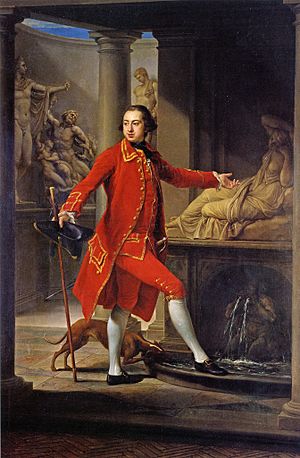Thomas Dundas, 1st Baron Dundas facts for kids
Quick facts for kids
The Lord Dundas
|
|
|---|---|
 |
|
| Member of Parliament for Richmond (Yorkshire) |
|
| In office 1763–1768 |
|
| Preceded by | The Earl of Ancram Sir Ralph Milbanke |
| Succeeded by | Alexander Wedderburn William Meeke |
| Member of Parliament for Stirlingshire |
|
| In office 1768–1794 |
|
| Preceded by | James Campbell |
| Succeeded by | Robert Graham |
| Personal details | |
| Born | 16 February 1741 Great Britain |
| Died | 14 June 1820 (aged 79) Great Britain |
| Spouse | Lady Charlotte FitzWilliam (m. 1764) |
| Children | 14 |
| Education | St. Andrews University |
Thomas Laurence Dundas, 1st Baron Dundas (born February 16, 1741 – died June 14, 1820) was an important Scottish politician. He was also a FRS, which means he was recognized for his contributions to science. He served in the British Parliament from 1763 to 1794. Later, he was given the title of Baron Dundas. He is famous for helping to create the Charlotte Dundas, which was the world's "first practical steamboat".
Contents
Who Was Thomas Dundas?
Thomas Dundas was the only son of Sir Lawrence Dundas, 1st Baronet, who was known as the "Nabob of the North" because he was very wealthy. His mother was Margaret Bruce.
Early Life and Political Career
Thomas went to school at Eton and St. Andrews University. After finishing his studies, he went on a "Grand Tour" of Europe, which was a common trip for young wealthy men at the time.
He then became a Member of Parliament (MP). This meant he was elected to represent people in the British government. He was an MP for Richmond from 1763 to 1768. After that, he represented Stirlingshire from 1768 to 1794.
In August 1794, he was given the title of Baron Dundas of Aske. This made him a "peer," which is a member of the nobility. He also held other important roles. He was the Lord Lieutenant for Orkney and Shetland, which meant he was the King's representative there. He was also a special advisor to the Prince of Wales, who later became King George IV.
Thomas Dundas was also the President of the Society of Scottish Antiquaries. This group studied old things and history in Scotland. He also led a military group called the North York Militia. In 1762, he bought Marske Hall in North Yorkshire. When his father passed away in 1781, Thomas became the 2nd Baronet and inherited Aske Hall. He also inherited property in Grenada.
The Famous Charlotte Dundas Steamboat
Thomas Dundas was very interested in the Grangemouth area and the Forth and Clyde Canal. This canal was being built from 1768 to 1790. He knew about the early tests of steam-powered boats on the canal. These tests were done in 1789 by Patrick Miller of Dalswinton and William Symington.
Building the Steamboat
In 1800, Dundas was the Governor of the Forth and Clyde Canal Company. He hired William Symington to design a steam tugboat. This boat was meant to pull other boats. Dundas showed a model of the boat to the canal company's directors. They agreed to start building it right away.
The boat was built based on Symington's design. It had successful tests on the River Carron in June 1801. It also successfully pulled sloops (small ships) from the river Forth up the Carron and along the Forth and Clyde Canal.
Trials and Challenges
However, other owners of the canal were worried. They thought the waves from the steamboat would damage the canal banks. Because of these worries, the company decided that the boat "would by no means answer the purpose." This meant they thought it wouldn't work out.
Symington then proposed an even better boat. He showed a model of it to Lord Dundas. This new boat would become famous as the Charlotte Dundas. It was named after one of Lord Dundas's daughters. One story says that Lord Dundas introduced Symington to the Duke of Bridgewater. The Duke was so excited that he immediately ordered eight similar boats for his own canal! Sadly, the Duke of Bridgewater died just a few days before the first trip of the Charlotte Dundas. So, his order was never completed.
Lord Dundas, along with some of his family and friends, was on board for the first trip of the Charlotte Dundas in 1803. Even though the boat worked very well, the fears about damaging the canal banks remained. The tests were stopped, and Symington ended up losing money on the project.
Family Life
Sir Thomas Dundas married Lady Charlotte FitzWilliam on May 24, 1764. Lady Charlotte was the daughter of William FitzWilliam, 3rd Earl FitzWilliam. They had a large family with 14 children!
Some of their children included:
- Lawrence Dundas, 1st Earl of Zetland (1766–1839)
- Lt-Col. William Lawrence Dundas (1770–1796), who died in Santo Domingo
- Charles Lawrence Dundas (1771–1810)
- Charlotte Dundas (1774–1855), who the famous steamboat was named after.
- R-Adm. George Heneage Lawrence Dundas (1778–1834)
- Maj-Gen. Sir Robert Lawrence Dundas (1780–1844)
See Also
Images for kids



